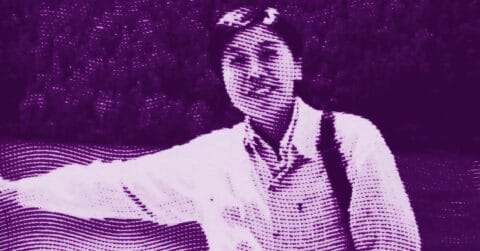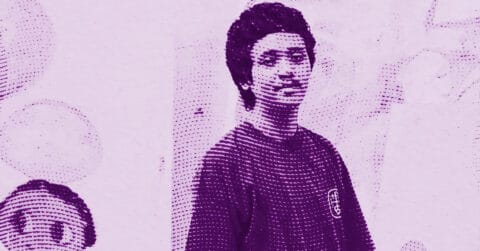Listen to me carefully, you bunch of snobs: Camille Henrot doesn’t just make art, she maps the collective unconscious of an era caught between its founding myths and its surveillance algorithms. This French artist, born in 1978, navigates with sharp intelligence the troubled waters of our hypermodernity, creating works that function as laboratories for experimenting with our most intimate contradictions.
Her artistic journey, marked by training in animation at the École Nationale Supérieure des Arts Décoratifs in Paris, immediately reveals a unique approach to creation. Unlike her contemporaries trained in traditional fine arts, Henrot develops a visual sensitivity nourished by popular culture, Japanese mangas, and the world of animation. This alternative training partly explains the fluidity with which she crosses media, video, sculpture, painting, installation, and ikebana, without ever being confined to a single practice.
Henrot’s work truly blossoms with “Grosse Fatigue” (2013), this thirteen-minute video that earned her the Silver Lion at the Venice Biennale. More than just a film, it is an aesthetic manifesto of our post-internet era. Set to hypnotic rap, she deploys a kaleidoscope of images drawn from the Smithsonian collections, creating a contemporary cosmogony mixing ancestral creation myths and scientific data. This work presciently anticipates the questions that would haunt the following decade: how to prioritize information in a world of cognitive overabundance? How to maintain a narrative coherence in the face of the fragmentation of digital reality?
“The Pale Fox” (2014), an installation that extends the reflections of “Grosse Fatigue,” transforms the exhibition space into a Klein blue domestic cosmos. On specially designed shelves, Henrot organizes a personal inventory of our contemporary chaos: National Geographic magazines, ethnographic sculptures, eBay objects, scientific books, and pornography. This accumulation is not accidental; it obeys a secret logic inspired by Dogon mythology and its four fundamental elements. The artist reveals her particular genius here: transforming the anxiety of informational accumulation into a contemplative aesthetic experience.
Psychoanalysis and motherhood: Art as a transitional space
The recent evolution of Henrot’s work reveals an increasingly assumed psychoanalytic dimension. Since the birth of her first child in 2018, she has explored with remarkable boldness the unexplored territories of motherhood in contemporary art. Her series “Wet Job” (2018-2020) marks a significant rupture in art history by representing for the first time the act of maternal breast pumping. These blood-red paintings, where elongated medieval figures manipulate mechanical pumps, reveal the gentle violence of contemporary motherhood.
This exploration naturally continues the research of Donald Woods Winnicott on the transitional space [1]. The British pediatrician and psychoanalyst theorized how the child uses certain objects and spaces to negotiate separation from the mother, creating an intermediate zone between internal reality and external reality. Henrot’s installations function precisely as such transitional spaces for the adult viewer. In “A Number of Things” (2025), her exhibition at Hauser & Wirth, she literally transforms the gallery into a playground with a grid-patterned green rubber floor, allowing visitors to temporarily regress into a state of playful exploration.
The dog sculptures in this exhibition, François, Margaret, Richelieu, and Herbert, leashed around a central pole, perfectly embody this ambivalence between care and control that Winnicott identified in the mother-child relationship. These hybrid creatures, oscillating between modernist art and children’s toys, reveal domestication as a process of socialization. Henrot thus questions the mechanisms through which we learn to internalize social norms, transforming the gallery into a laboratory for observing our conditioned behaviors.
Her “Abacus” series (2024) extends this reflection by monumentalizing elementary learning tools. These bronze sculptures with biomorphic shapes transform the act of counting into a sensual and bodily experience. The artist thus reveals how abstract systems of quantification are embodied in our bodies, shaping our relationship with the world from childhood. The palindromic titles of some pieces, “73/37”, “347/743”, highlight the reversibility of the processes of meaning, reminding us that every reading is also a writing, every reception a creation.
The architecture of intimacy and the power of algorithms
Another fundamental dimension of Henrot’s work lies in her architectural analysis of contemporary intimacy. Raised in a family environment where her father contributed to the development of the Minitel, the French precursor to the Internet, she has an intuitive understanding of the telecommunication issues structuring our era. Her “Interphones” (2015) materialize with formidable efficiency the mechanisms of capitalist surveillance described by Shoshana Zuboff [2].
These telephone sculptures, deliberately retro in form, offer automated services that insidiously collect our personal data. “Is He Cheating on You?” asks for your bank details under the guise of marital advice, while “Dawg Shaming” mixes canine problems and domestic violence in an unsettling semantic confusion. Henrot thus reveals how our era transforms intimacy into an extractable commodity, our emotions into exploitable data.
Domestic architecture becomes for her a critical experimental ground. In “Saturday” (2017), she juxtaposes baptismal ceremonies and cosmetic procedures, revealing the new liturgies of self-transformation that structure our media-saturated daily life. This nineteen-minute video functions as an archaeology of the present, unearthing contemporary rituals of purification and rebirth beneath their technological veneers.
The installation “Days Are Dogs” (2017) at the Palais de Tokyo takes this logic of architectural immersion further. By coloring the entire space ultramarine blue, walls and carpet alike, Henrot creates a total environment that dissolves usual spatial references. This strategy of sensual enveloping reveals her inheritance from minimal art, but diverted towards an exploration of affect and controlled regression.
Her recent series “Dos and Don’ts” (2021) examines with biting irony the etiquette manuals she discovered at her mother’s. These painting-collages mix Victorian etiquette precepts and screenshots of computer errors, revealing the permanence of social normalization mechanisms under their technological avatars. Dental X-rays are juxtaposed with embryology lab invoices, attesting to the growing medicalization of ordinary existence.
In these works, Henrot develops an aesthetic of digital trompe-l’oeil that deliberately blurs the boundaries between manual production and algorithmic generation. This formal ambiguity reflects our increasing difficulty in distinguishing the authentic from the artificial in a world saturated with computer-generated images. The artist does not lament this evolution but explores its creative potential, transforming the contemporary anxiety of simulation into an aesthetic resource.
An aesthetics of productive ambivalence
Camille Henrot’s particular strength lies in her ability to maintain ambivalence without prematurely resolving it. Her works neither denounce nor celebrate our contemporary contradictions but make them perceptible and thinkable. This aesthetic position resembles what Melanie Klein identified as the “depressive position,” the psychic capacity to tolerate the coexistence of contradictory affects towards the same object [3].
Her hybrid sculptures perfectly embody this logic: neither purely abstract nor clearly figurative, they maintain a productive formal undecidability. “Misfits” (2022), that children’s sorting cube with a cylinder forced into a square hole, thus becomes a metaphor for our constitutive maladaptation to the systems that shape us. The work reveals the gentle violence of socialization while retaining a playful dimension that forbids pathos.
This aesthetic of ambivalence finds its most accomplished expression in her India ink drawings. These works on paper reveal the artist’s technical virtuosity, inherited from her childhood passion for drawing. Executed with a remarkable economy of means, they capture the essence of a form in a few decisive gestures. Henrot reveals her filiation with Saul Steinberg, that master of the clever line who knew how to condense entire universes into a curve.
Her ikebana practices, developed since 2010, extend this search for a minimal form bearing maximum meaning. Each floral arrangement honors the memory of a book read, transforming reading into a ritual of mourning and rebirth. This practice reveals a melancholic dimension of her work, that acute awareness of the fragility of all cultural transmission in a world of permanent acceleration.
The exhibition “A Number of Things” at Hauser & Wirth (2025) synthesizes fifteen years of artistic research by offering a total environment that functions as a reduced model of our contemporary condition. The green rubber floor simultaneously evokes a playground and an operating room, revealing the constitutive ambiguity of our care spaces. The monumental sculptures of the “Abacus” series transform calculating tools into sensual totems, revealing the repressed erotic dimension of our relationship to numbers.
In this installation, Henrot reveals her mastery of architectural space as an extension of sculpture. Every element, floor, lighting, and circulation, participates in an overall dramaturgy that transforms the visit into an initiatory journey. The artist demonstrates that contemporary art can still create total experiences without descending into spectacle, by mobilizing our sensitive intelligence rather than our consumerist reflexes.
Towards a new ecology of attention
Camille Henrot’s work flourishes at the very moment when our societies become aware of the ecological crisis of attention. In a world saturated with information and stimuli, she offers devices for slowing down and concentrating that restore our contemplative capacity. Her installations function as therapeutic environments that relearn us to inhabit space and time with presence.
This ecological dimension of her work particularly shines through in her collaborations with the Sogetsu School of ikebana in Japan. By appropriating this millenary practice, Henrot reveals how certain traditional forms can still nourish our contemporary sensitivity. Her floral arrangements bear witness to a search for balance between control and letting go, composition and improvisation, permanence and ephemerality.
The artist thus develops an ecology of attention that does not reject technology but questions its uses. Her “Interphones” reveal the traps of automation while maintaining a playful dimension that avoids sterile technophobia. Similarly, her “Dos and Don’ts” paintings use digital tools to question the digitization of daily life, in a reflective movement that avoids reactionary nostalgia.
This nuanced stance towards technical modernity reveals Henrot’s intellectual maturity. Unlike many artists of her generation, she neither falls into the naive celebration of progress nor its apocalyptic denunciation. She develops an immanent critique that works from within contemporary contradictions, revealing their emancipatory potentials as well as their dangers.
The “Sweet Days of Discipline” installation at the Kunstmuseum St. Gallen (2023) exemplifies this nuanced approach. By bathing her canine sculptures in lavender-colored and Kelly green light, Henrot transforms the question of training into a soothing aesthetic experience. The work thus reveals the productive dimension of certain constraints, without legitimizing all control systems.
This ability to maintain complexity without simplifying it reveals the deep influence of psychoanalysis on her artistic approach. Like practitioners of analytical therapy, Henrot creates devices that allow the emergence of the unexpected. Her installations function as transitional spaces where our repressed ambivalences, our contradictory desires, our unspoken fears can unfold.
The artist thus reveals that contemporary art can still play a therapeutic role without falling into complacency or demagoguery. By creating environments that respect the intelligence of the viewer while soliciting her sensitivity, she restores a social function of art that cultural commodification had largely eroded.
Camille Henrot’s work ultimately teaches us that resistance to contemporary homogenization does not pass through nostalgic return to an idealized past, but through the invention of new forms of subjectivation. Her installations propose models of existence that assume the complexity of the present without giving up transforming it. In a world that constantly urges us to choose between false alternatives, she keeps open the space of play, experimentation, and metamorphosis.
Her recent international exhibitions, from the Palais de Tokyo to Hauser & Wirth and the Kunstmuseum St. Gallen, bear witness to the critical recognition of this singular approach. Henrot is progressively establishing herself as one of the most interesting voices of her generation, capable of translating the anthropological mutations of our time into sensitive forms.
At a time when contemporary art too often oscillates between disembodied formalism and reductive activism, Camille Henrot invents a third way that reconciles aesthetic rigor and political relevance. Her works remind us that art can still be a laboratory for experimenting with possibilities, a space of creative freedom that helps us imagine other ways of being in the world.
From this perspective, Henrot’s work far exceeds the boundaries of contemporary art to question the very foundations of our modern condition. By revealing the hidden mechanisms of our socialization, she restores to us some of our capacity to act on our own determinisms. By transforming our anxieties into aesthetic resources, she teaches us to creatively inhabit our contradictions. By keeping the space of play open at the heart of our contemporary concerns, she reminds us that art remains one of the last possibilities to escape the generalized reification of existence.
The artistic universe of Camille Henrot is thus much more than a simple corpus of works: it is a true ecosystem of forms and meanings that helps us navigate contemporary complexity without getting lost. By creating devices that simultaneously respect our intelligence and our sensitivity, our need for meaning and our desire for beauty, she restores an anthropological function of art that our era had believed definitively obsolete. Her work ultimately teaches us that true sophistication does not consist in simplifying the complex, but in making the complex habitable.
- Winnicott, Donald Woods, Holding and Interpretation: Fragment of an Analysis, London, Hogarth Press, 1986.
- Zuboff, Shoshana, The Age of Surveillance Capitalism: The Fight for a Human Future at the New Frontier of Power, New York, PublicAffairs, 2019.
- Klein, Melanie, Developments in Psychoanalysis, London, Hogarth Press, 1952.
















